Physical Address
304 North Cardinal St.
Dorchester Center, MA 02124
General indications for routine abdominopelvic CT or MRI evaluation of the upper GI tract include:
Assessment of patients with clinical symptoms or signs potentially related to GI tract pathology for detection and characterization of the underlying etiologies.
Staging, pretreatment planning, response assessment, and restaging of patients with known GI tract malignancy.
Assessment of patients with suspected or known infectious, inflammatory, or ischemic bowel disease.
Assessment of patients with traumatic injury to the abdomen or pelvis for detection of bowel injury.
Evaluation of patients with known bowel obstruction to elucidate the underlying etiology.
Routine CT is typically performed using axial 5-mm sections during the venous phase of intravenous contrast enhancement following the administration of barium- or iodine-based positive oral contrast material. Positive oral contrast material increases the attenuation of the bowel lumen relative to the bowel wall while simultaneously distending the bowel lumen. Therefore, this type of oral contrast material is most often used to improve the detection of intraluminal bowel pathology and to detect and localize bowel leaks, particularly after prior bowel surgery.
Routine MRI is typically performed using multiplanar T1-weighted, T2-weighted, and diffusion-weighted image acquisitions, followed by dynamic contrast-enhanced T1-weighted imaging. However, oral contrast material is generally not administered.
CTE and MRE are tailored specifically for detailed evaluation of the small bowel. They are both obtained through the abdomen and pelvis after the administration of large volumes (>1 L) of neutral oral contrast material. Neutral oral contrast material has fluid attenuation on CT and fluid signal intensity on MRI (i.e., low T1-weighted and high T2-weighted signal intensity). This improves the distinction between the bowel wall and the bowel lumen while simultaneously distending the bowel lumen, allowing for improved detection of abnormal bowel wall pathology. Multiplanar thin section images are then typically obtained during one or more phases of intravenous contrast enhancement. MRE has superior soft tissue contrast compared to CTE, improving the detection of mural edema and mural hyperenhancement, and involves no radiation exposure but is more expensive and takes longer to perform than CTE.
CTE and MRE are most often performed for:
Assessment of patients with suspected or known Crohn's disease to determine disease activity, disease extent, presence of disease complications, and disease response to therapeutic intervention.
Assessment of patients with obscure GI bleeding to detect the presence, site, and etiology of GI hemorrhage.
The normal bowel wall is generally ≤3 mm in thickness when well distended. However, the gastric antrum and pylorus may normally measure up to 11 mm, and underdistended portions of normal bowel may also appear to be thicker than 3 mm but without asymmetric thickening or abnormal enhancement ( Figure 25-1 ). On unenhanced CT and MR images, the wall of the bowel attenuation and signal intensity are similar to those of skeletal muscle. On contrast-enhanced CT and MR images, the bowel wall normally has uniform homogeneous enhancement that is typically less than or similar to that of the liver. However, the normal gastric wall may sometimes have a stratified enhancement pattern, where the mucosal layer (and sometimes the serosal layer) has greater enhancement than the submucosal layer.
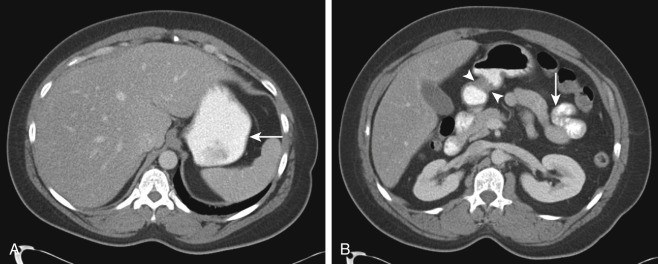
The esophagus typically appears underdistended, and the stomach may be variably distended on cross-sectional imaging. The small bowel is generally ≤3 cm in caliber, and the jejunum typically has thicker, taller, and more numerous (4 to 7 per inch) valvulae conniventes (also called folds of Kerckring or plicae circulares) than the ileum (2 to 4 per inch).
Wall (mural) thickening is the hallmark of GI tract pathology seen on cross-sectional imaging. In general, the greater the degree of mural thickening, the more likely that malignancy is the underlying etiology. Bowel wall thickness <1.5 cm is generally nonneoplastic in etiology, whereas bowel wall thickness >1.5 cm is usually due to malignancy. Asymmetric wall thickening and focal wall thickening are also generally suggestive features of malignancy, although nonneoplastic diseases of the bowel may sometimes also be asymmetric or focal. Surrounding fat stranding greater than the degree of wall thickening favors an inflammatory etiology.
On CT, the “target” sign, also known as mural stratification, refers to visualization of a bright soft tissue attenuation inner layer (representing mucosa, lamina propria, and hypertrophied muscularis mucosae, sometimes with hyperemia), a dark low-attenuation middle layer (representing edematous submucosa), and sometimes a bright soft tissue attenuation outer layer (representing muscularis propria and serosa); the alternating layers correspond to the rings of a target ( Figure 25-2 ). On MRI, a similar bright-dark-bright pattern is seen on contrast-enhanced fat-suppressed T1-weighted images, whereas a dark-bright-dark pattern is seen on T2-weighted images, because fluid and edema are high in signal intensity on T2-weighted images.
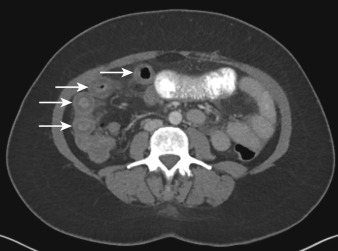
This sign is not specific for a particular disease condition but is highly specific for the diagnosis of nonneoplastic disease (edema, infection, inflammation, ischemia) when encountered in the small bowel. However, this specificity for nonneoplastic disease does not hold when it is encountered in the stomach, as scirrhous carcinoma may also have a “target” sign.
The “fat halo” sign indicates the sequelae of prior inflammatory disease and is characterized by fat attenuation in the submucosa with relative hyperattenuation of the mucosa and muscularis propria or serosa on CT. On MRI, fat signal intensity is seen in the submucosa. This finding is nonspecific and can also be seen in normal bowel.
The “comb” sign is due to engorgement of the perienteric or pericolic vessels which, when viewed en face, mimic the tines of a comb radiating away from the bowel. This is usually encountered with infectious or inflammatory disease of the bowel, most often with Crohn's disease.
The “small bowel feces” sign is due to the mixture of particulate debris and gas bubbles within the small bowel lumen, mimicking the appearance of fecal material that is normally encountered in the large bowel. It is due to incompletely digested food, bacterial overgrowth, and/or increased water absorption secondary to stasis. This finding generally indicates presence of a small bowel obstruction and is typically encountered just proximal to the site of obstruction ( Figure 25-3 ).
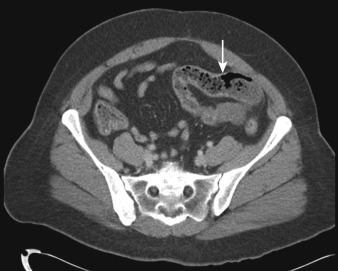
Active GI bleeding typically appears as a focus of high attenuation or high signal intensity contrast material within the lumen of a portion of the bowel during the arterial phase of enhancement, which then progressively enlarges over time during the venous or delayed phases of enhancement.
Malposition of the duodenojejunal junction (ligament of Treitz) from its normal location to the left of the spine at the level of the duodenal bulb
A predominance of small bowel loops in the right abdomen and of large bowel loops in the left abdomen ( Figure 25-4 )
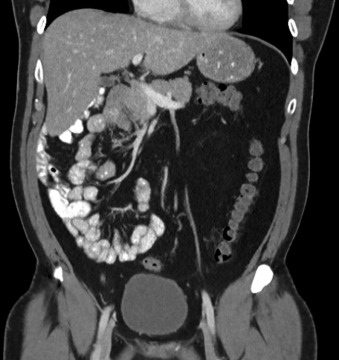
Inversion of the normal relationship of the superior mesenteric vein (SMV) and superior mesenteric artery (SMA). The proximal SMV is normally seen anterior to and to the right of the proximal SMA, but in the setting of bowel malrotation, the proximal SMV may instead be located anterior to and to the left of the proximal SMA
For the answer, see Box 25-1 . Gastroesophageal reflux (GER) and infectious esophagitis (typically in immunocompromised patients) are the most common causes of esophagitis, and Candida albicans is the most common cause of infectious esophagitis. Caustic ingestion is most often due to the ingestion of lye (sodium hydroxide), either accidentally in children or during suicide attempts in adults.
GER
Infection
Candida albicans
Herpes simplex virus (HSV) type 1
Cytomegalovirus (CMV)
Human immunodeficiency virus (HIV)
Mycobacterial infection
Oral medications
NSAIDs
Tetracycline or doxycycline
Potassium chloride
Radiation therapy
Caustic ingestion
Crohn's disease
Segmental or diffuse smooth circumferential wall thickening of the esophagus is seen ( Figure 25-5 ). Sometimes, increased mural enhancement, increased mural T2-weighted signal intensity relative to skeletal muscle, a “target” sign, luminal narrowing, surrounding fat stranding, intramural tract or abscess formation, or fistula formation between the esophagus and other structures such as the tracheobronchial tree or stomach may also be seen.
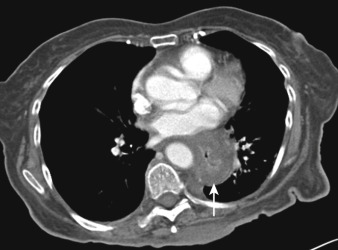
Achalasia is an uncommon esophageal dysmotility disorder in which there is absent esophageal peristalsis and impaired or absent relaxation of the lower esophageal sphincter during deglutition. The two major forms are primary achalasia and secondary achalasia.
Primary, or idiopathic, achalasia is caused by degeneration of myenteric plexi in the esophageal wall, whereas secondary achalasia (or pseudo-achalasia) is a less common form caused by other conditions (especially malignant tumors) that lead to an achalasia-like motility disorder. Differentiation of these two forms is important because primary achalasia is generally treated with botulinum toxin injection, pneumatic dilation, or laparoscopic myotomy, whereas secondary achalasia usually requires diagnostic workup and treatment of the underlying malignancy.
Primary achalasia typically presents clinically with long-standing slowly progressive dysphagia usually in adult patients <50 to 60 years of age. On cross-sectional imaging, smooth tapered narrowing of the distal esophagus is seen, sometimes with mild smooth wall thickening, in association with upstream esophageal dilation, which can be massive and associated with retained ingested debris. No soft tissue mass at the gastroesophageal junction, regional lymphadenopathy, or distant metastases are seen ( Figure 25-6 ).

Secondary achalasia typically presents clinically with a more acute onset and a more rapid progression of symptoms (usually within 6 months) in older patients (usually >60 years of age). On cross-sectional imaging, upstream esophageal dilation is again seen, but additional suggestive imaging features may be present including distal esophageal wall thickening that is nodular, lobulated, or asymmetric; a soft tissue mass at the gastroesophageal junction; regional lymphadenopathy or distant metastatic disease. Adenocarcinoma of the gastric cardia, gastric fundus, or distal esophagus is the most frequent tumor that causes secondary achalasia.
Esophageal varices are dilated venous collaterals in or around the esophageal wall. On CT and MRI, they appear as tubular or serpentine structures in or around the esophageal wall that enhance to a degree similar to that of other systemic veins, resulting in a thickened lobulated appearance of the esophageal wall ( Figure 25-7 ).
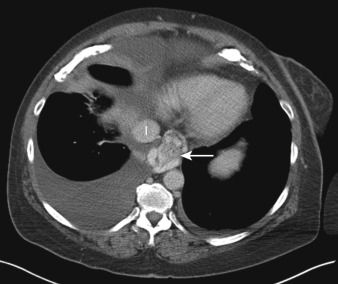
Uphill varices of the esophagus are secondary to portal hypertension and are typically seen in the lower third of the esophagus (see Figure 25-7 ). Downhill varices of the esophagus are secondary to superior vena cava (SVC) occlusion and are typically seen in the upper and middle thirds of the esophagus (if the site of obstruction is superior to the junction of the azygos vein and SVC) or in the esophagus diffusely (if the site of obstruction is inferior to the junction of the azygos vein and SVC).
Become a Clinical Tree membership for Full access and enjoy Unlimited articles
If you are a member. Log in here